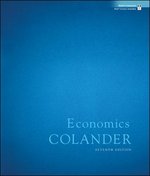Question
The Great Recession has officially ended in June 2009, according to the NBER Business Cycle Dating Committee. However, the unemployment rate peaked only in October
- The Great Recession has officially ended in June 2009, according to the NBER Business Cycle Dating Committee. However, the unemployment rate peaked only in October 2009.This could be interpreted as follows:
a. The NBER committee likely announced the end of the recession too early
b. There was something unusual about this recent business cycle if unemployment rose after the recession ended
c. This rise in the unemployment rate was most likely a result of workers becoming discouraged and dropping out of the labor force
d. It is normal for unemployment to continue rising even after the recession is "officially" over
2."Gross domestic product of Romeria fell 0.3% in the fourth quarter of 2011... with the latest survey data suggesting the economy will contract again in the first quarter of 2012... The new downturn followed seven quarters of weak growth after the country's 2008-09 recession." Based on the popular definition of recession, at the moment of writing, the economy of Romeria
a. had been in recession continuously since 2008
b. was most likely in recession already, but we can't tell for sure until data on GDP growth for the 1st quarter of 2012 is reported
c. was in recession during the second half of 2011
d. would have been in recession only if GDP continued to contract through all of 2012
3.Susan switches from going to Speedy Lube for an oil change to changing the oil in her car herself. Which of the following is correct?The value of changing the oil is
a. included in GDP if Susan pays Speedy Lube to change it but not if she changes it herself.
b. included in GDP whether Susan pays Speedy Lube to change it or changes it herself.
c. included in GDP if Susan changes it herself, but not if she pays Speedy Lube to change it.
d. not included in GDP whether Susan pays Speedy lube to change it or she changes it herself.
4.In 2004, based on concepts similar to those used to estimate U.S. employment figures, the Japanese adult non-institutionalized population was 109.684 million, the labor force was 65.760 million, and the number of people employed was 62.630 million.According to these numbers, the Japanese labor-force participation rate and unemployment rate were about
a. 57.1% and 2.9%
b. 60% and 4.8%
c. 57.1% and 4.8%
d. 60% and 2.9%
5.If the natural rate of unemployment is 5.2 percent and the actual rate of unemployment is 5.7 percent, then, according to the second definition of "full employment"
a. structural unemployment accounts for 5.2 percentage points of unemployment.
b. search unemployment accounts for 5.7 percentage points of unemployment.
c. frictional unemployment accounts for 0.5 percentage points of unemployment.
d. cyclical unemployment accounts for 0.5 percentage points of unemployment.
Step by Step Solution
There are 3 Steps involved in it
Step: 1

Get Instant Access to Expert-Tailored Solutions
See step-by-step solutions with expert insights and AI powered tools for academic success
Step: 2

Step: 3

Ace Your Homework with AI
Get the answers you need in no time with our AI-driven, step-by-step assistance
Get Started


